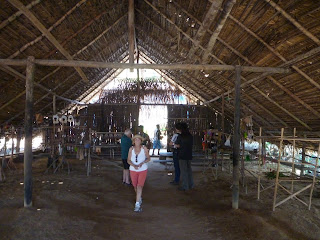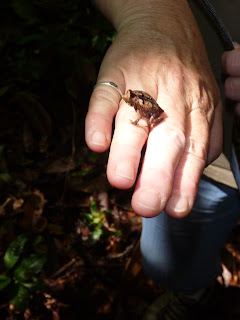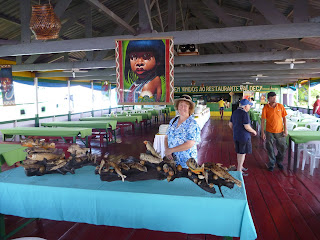Recently, my sister, Stephanie, and I took a "once-in-a-lifetime" trip to Amazonas, Brazil. Just the two of us. Alone. In the Amazon. Not speaking Portuguese. Can you say "CRAZY"?!! I shall try to chronicle that adventure here, with all of the "cultural experiences" that it entailed.
We boarded a plane for Manaus on Tuesday morning, and this is where the adventure began. Actually, the flight was pretty uneventful... until we began our decent at the Manaus airport. We began going down-- at quite a steep angle, in my opinion-- when, all of a sudden, the pilot pulled the nose up, rather sharply and abruptly. I don't know if we missed the runway, or we were directed by ground control to make another try. Soon, the pilot came on over the speakers, and in a low, staticky voice said something about a re-approach. (Can anyone ever understand what a pilot says from the cockpit? I think they hold those radio things pressed tightly against their lips and then purposely speak in the most unintelligible voice possible. Not to mention this was in Portuguese.) Anyway, Steph and I had already assumed an emergency landing position and I couldn't hear anything over her cries. (I might add here that I was the picture of serenity through the entire ordeal.)
We made a HUGE pass over what seemed like the
entire Amazon Rain Forest, traveling at a very low altitude; just skimming the trees. Seriously, there were birds flying next to our windows. You try to keep your calm when your older sister is next to you in a fetal position, babbling about birds being sucked into the engines. I am relieved to say that we landed, without further incident, and were even able to come to a screeching halt on an
extremely short runway. Now that things were settled down, we were able to sit upright again and look out the window as we taxied to the building. We shouldn't have. We should have kept our heads down and our window shades drawn. We passed three planes that looked like they had been dredged up from the bottom of the Amazon river. I am not exaggerating. They were black with mold or algae or something, and I swear there were vines hanging off of them. Spooky. If there are any film producers out there, thinking of making a horror film about haunted airplanes, you need look no further than the Manaus International Airport.

We could have just turned back for home at this point, having all the adventure we could handle, but I didn't like our chances of not getting one of those eerie planes. So, we collected our baggage and found a taxi. I have never arranged for a taxi in English, let alone a foreign language. In fact, there were a lot of firsts for me on this trip. I'd like to say that I confidently walked over to the line of taxis and hailed a driver. But, in reality, we just kind of hummed and hawed on the sidewalk until one walked up to us and asked if we needed a ride. And that is how we met Joao Bezerra.
Joao seemed to be having a bad day. He wore a harsh, surly scowl, with deep lines etched into his forehead; suggesting that this grimace is a common expression for him. My sister was kind enough to push me into the front seat with our sulky chauffeur. We rode in brooding silence for quite some time, until I could stand it no longer. I began to speak--to lighten the mood. If any of you have ever heard me trying to speak Portuguese, you know that nobody within earshot can stay serious for too long...it's just too hilarious. Soon, Joao's expression softened-ever so slightly-and he opened up to us. As it turns out, taxi driving is only his day job. I think he'd really like to make it big as a singer. He sings love songs... in English. And he doesn't understand a word of what he sings--nope, not one word. He rummaged around on the side of his seat and produced a CD of his music; handing it to me. And there he was on the cover--same scowling face. But, in fact, he is not permanently
angry--just a misunderstood, heartsick taxi driver/lounge singer. Now we were in for a real treat. He inserted the CD into the player of the car and turned it up--full blast. With the windows down, he crooned at the top of his lungs. At one point, just as we were slowing for a speed bump, we came upon an unsuspecting taxi driver heading in the opposite direction. I thought that perhaps Joao knew this other driver, as he leaned further out the window toward the man, flourishing his arms dramatically, and singing with greater enthusiasm. The driver gave only what can be described as a look of alarm, before he revved the engine and tore out of there. This only encouraged Joao further, as he pulled up to the entrance of the hotel, with speakers blaring, singing his heart out. He left us a copy of his CD as a lasting memory; refusing money, but instead insisting we take it as our first souvenir. I liked Joao. He may have scared me a little at first. I may have misunderstood his ornery look. But, in the end, I liked him. So, this is why I will share a little bit of his work right
here. I'm sure he won't mind. And, if there are any big music producers out there, just let me know, and I will give you his contact information.
We stepped into our hotel, the Tropical Manaus, immediately accosted by the strong scent of mold- mixed with ammonia. It was a really cool, old, Colonial style hotel with lots of woodwork, wide, expansive hallways, and giant rooms. It did have the constant smell of mildew, but we soon learned why. We also learned that we really did have to throw our towels on the floor if we wanted clean ones in the morning. And, trust me, we wanted clean ones. You could dry off and hang your towel up neatly after your shower, only to find it MORE wet
24 hours later. And, I think that mold may have begun to form on the towels in that short time, judging from the odor. I have never before been
attacked by humidity like that. This got me to thinking: In a country where the majority of the people hang their clothes out to dry, how do they ever get their laundry done? So, even though it smelled bad, I would have to recommend the hotel--for the overall ambiance. (And, of course, for the excellent breakfast buffet!) I wish I would have taken more pictures of the interior. Here is the one I did take of our hallway:
Like stepping back in time

Our hotel was situated on the Rio Negro. This made our daily boat excursions very convenient for departure. On day one, we took the "Meeting of the Waters" tour. We boarded a boat, with an "English speaking" guide. He would rattle on and on for five minutes in Portuguese, then he would "interpret" for us--in about five words. I was just glad to have those few words in English, because I couldn't understand a thing he was saying, otherwise. We cruised down stream (I say that like it didn't look like we were on the ocean--or at least a Great Lake.) This river is massively wide--and it's only a tributary of the Amazon. There is an island in the middle of it that our guide says takes 13 hours to circumnavigate. An island! We were there at the river's highest point (just after the end of the rainy season). The river rises and falls something like 25 meters between rainy and dry seasons. Because of this swelling of the river, the width was particularly great, and the height was such that we were actually floating at the tops of the trees!
That's the top of a tall tree!
The trees have adapted to survive in the flood plain.
Anyway, we "cruised downstream" for about an hour, until we came to the "Meeting of the Waters"--the place where the black Rio Negro and the brown Rio Solimoes meet to become the Amazon River. Because of the differences in temperature, density, and velocity of the two rivers, they don't mix, but actually run side by side for about six miles. It is an awesome sight!
The lovely Stephanie:
It went on as far as you could see. It was really weird.
To me, it looked like coffee and coffee with cream.
All along the river, there are these "floating meadows" They looked like carpets of grass, rippling on the waves, and a good hunting ground for fowl:
A close-up of the floating meadow with cool birds:
Next, we continued back along the Rio Negro to the January Ecological Park and floating restaurant. Along the way, we saw a pink river dolphin playing in the water. (I wasn't quick enough to get a shot, but it sure freaked me out at first to see something that big emerging from the murky water.) We also saw the local houses. People build their houses on stilts or floating pontoons, to deal with the ever changing river. As we were there during the highest water level, the houses looked like they were just sitting on the river:
They just got electricity last year! Look at the power lines.
Can you see the tree in the front "yard"?:
Some of these houses were not connected to any land at all, as far as I could see. They had a sort of veranda all the way around the house, and there were children and dogs playing and/or lounging about on the narrow walkways. What a different life!
We got to the floating restaurant--a large covered platform on pontoons--and enjoyed a delicious buffet lunch, complete with the usual--rice, beans, farofa (the toasted flour of the manioc root), chicken, and two kinds of fish from the river. Also, and for those a little more adventurous, they offered two unrecognizable-- and I don't mind saying, unappetizing--looking dishes. I asked and found out that they were purees of the fish, mixed with the starchy manioc. The result was an orange-ish glop of stuff with the consistency of thick snot. Steph tried it. Even the Brazilians weren't eating it! Brave Sister. (I actually tried a microscopic bite off of her plate, and the flavor wasn't so bad. The texture, however...ew.) We both tried the fish. My favorite was the Pirarucu; "the world's largest fresh water fish, it can grow up to almost 10 feet long and weigh over 600 pounds!" It had the flavor and consistency of pork. We later watched our guide, at another stop, try to catch these monstrous fish, so we could see their size. They made incredibly loud smacking sounds as they came out of the water, chomping at the fish on the end of his rope. There were children swimming in the river just yards away. Children smaller than these fish...
The floating restaurant:
When we finished eating, I went to use the restroom. I sat on the toilet and caught some movement in between the floor boards out of the corner of my eye. I thought that it looked like people moving around, way down below. For a second, I thought, "Well, that's creepy that those people can look up here and see me using the toilet!" I bent down a little further to get a closer look. This is when I remembered that we were on a
floating restaurant; there is no lower floor. Now, as my eyes adjusted to the dim lighting, I could see clearly that these were not people moving far below, but instead, the movement was more of a slithering motion occurring
directly below the floor boards. At that moment, the moving "object" popped it's diamond shaped head up through a hole in the floor and stared at me with it's green eyes. I was having a staring contest (whilst in a compromising position, I might add) with a huge snake! I was paralyzed. It was probably only seconds, but it seemed like an eternity, as I sat there weighing out my options. The hole was between myself and the door, but I was prepared to bolt--with my pants around my ankles, if necessary. I guess I wasn't worth his time, because, just as I was about to make my move, the snake started to slither off on the joist just below the floor. Let's just say, I finished my business quickly and got the heck out of there! I wasn't able to warn the lady waiting for the stall before she slipped in after me, but I did tell the next lady in line (her friend, I think). I couldn't think of the word for floor, so I just stomped on the ground, pointed down, and said, "Cobra! Cobra!" (the word for snake). After a few minutes of confusion, she got my gist and yelled through the door to her friend. All the while, the boat driver, who was sitting nearby, was laughing hysterically. What did I tell you about my Portuguese?
Our tour was not over yet. After I got over the unscheduled "Snake Encounter" part of the tour, it was time to move on to the "January Ecological Park" visit. We walked off the back of the restaurant and along a long wooden walkway on stilts, through the flooded jungle, to a lake covered in giant lily pads. Our guide told us that in the dry season, the platform is nine meters up in the air. But now, the water was almost level with the bottom of the walkway. The lily pads look like something out of an episode of Wild Planet. The guide told us about their life cycle, and we could see specimens in each stage of the cycle. It was very cool. We also spotted a baby caiman sunning itself on one of the pads. And on the way back, we watched Howler Monkeys playing in the treetops. Awesome!
Walkway on stilts
Giant Water Lilies
Baby Caiman

We returned to the restaurant, and from there, boarded motorized canoes for an exciting trip through a maze of submerged jungle trees. Apparently, we followed a path that, if during the dry season, we would have taken on foot. The passageway was so narrow that, at times, we were whipped in the face by the foliage. At one point, our guide had the drivers cut the motors on the canoes, and we observed two minutes of "silence". Here we were, surrounded by the denseness of the Amazon Rain Forest, listening to the exotic sounds of tree frogs, tropical birds, and who knows what else? It was one of the coolest moments of my life. I was also somewhat relieved at that same moment that we hadn't signed up for the "Piranha Fishing/Crocodile Hunting in the Dark" (with a Portuguese-only speaking guide) expedition. The jungle is a little spooky in broad daylight! We turned the motors back on, and I looked up to see a Scarlet Macaw soaring overhead. Breathtaking! Can I stop right here to publicly thank my awesome husband, Tom, for this once-in-a-lifetime opportunity? He sacrificed his time to stay home with
four kids, sending me out on this unforgettable adventure. Thank you, Honey! I don't deserve you! (Except, I will mention that I was crowned Queen of the Jungle. But, we'll get to that later.)
What a fantastic day! We returned to the hotel, hot, sweaty, tired, SWEATY, (did I mention the humidity?) and happy, only to spot one last creature, just steps away from our hotel:
Mr. Sloth was too lazy to give us a head shot.
Coming shortly: Amazon Adventure Part II


.jpg)




















































